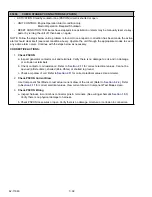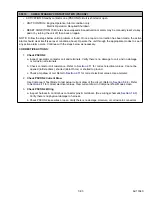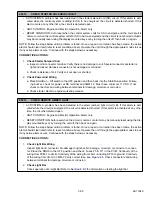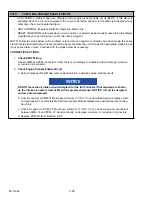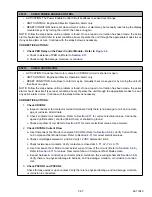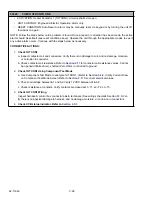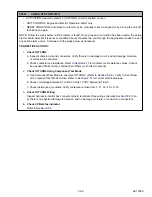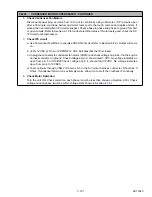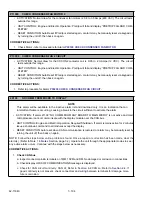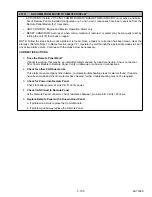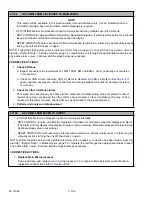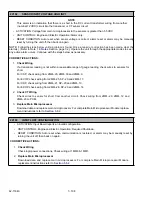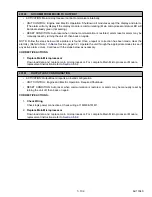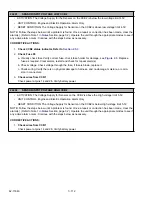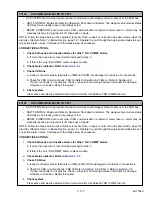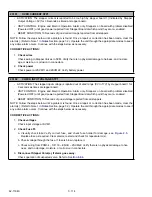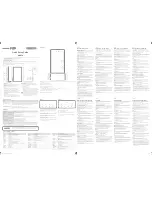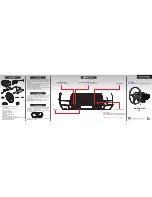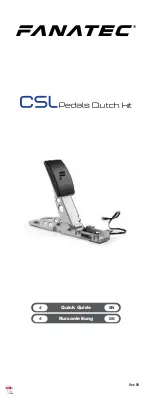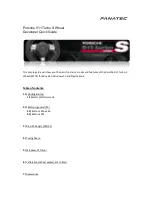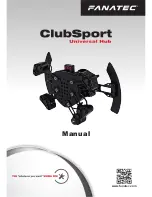
62-11640
7–102
06001
CHECK LIGHT BAR
• ACTIVATION: A problem has been detected in the light circuit (LB). If this alarm is activated while the cir-
cuit is energized, the circuit is detected shorted. If this alarm is activated at any other time, the circuit is
detected open.
• UNIT CONTROL: Engine and Electric Operation: Alarm only.
• RESET CONDITION: Auto reset when the circuit is normal, or alarm may be manually reset using the dis-
play mounted keys or by turning the unit off, then back on again.
NOTE: Follow the steps below until a problem is found. Once a repair or correction has been made, the active
alarm should clear itself (refer to reset condition above). Operate the unit through the appropriate modes to see
if any active alarm occurs. Continue with the steps below as necessary.
CORRECTIVE ACTIONS:
1.
Check Light Bar Wiring
Inspect light bar & connector. Verify there is no damage to light bar, and no damage, moisture, or cor-
rosion in connector. Place the SROS in the OFF position and check:
• Fuses F5 & F11 in the PCM, continuity of the wiring from PCM-7 to LB-B, continuity of the wiring from
LB-G -including SP10 to ground, continuity of the wiring from LB-H to 3MM-7
Verify correct fuse, see
. Check connectors and wiring between terminals for damage,
moisture or corrosion.
2.
Check Light Bar
Check operation of 2-Light Bar Refer to
for information on testing the light bar.
07000
ECONOMIZER TEMP SENSOR
• ACTIVATION: Economizer temp sensor is out of range
• UNIT CONTROL: Engine and Electric Operation: Alarm only. Economizer forced to STANDARD mode
when alarm is active.
• RESET CONDITION: Auto reset or alarm may be manually reset using the display mounted keys or by
turning the unit off, then back on again.
NOTE: Follow the steps below until a problem is found. Once a repair or correction has been made, clear the
alarm(s). (Refer to Note 1 in
Section, page 7-2.) Operate the unit through the appropriate modes to see if
any active alarm occurs. Continue with the steps below as necessary.
CORRECTIVE ACTIONS:
1.
Check Sensor
a. Inspect sensor & connector. Verify there is no damage to sensor, and no damage, moisture, or cor-
rosion in connector.
b. Check sensor resistance (Refer to Note 3 in
Section, page 7-2.) 10,000 Ohms @ 77°F
(25°C.) See
for complete table of temperatures and resistance values.
2.
Check Sensor Wiring
a. Inspect connector pins & terminals at sensor and connector 2MM. (See wiring schematic
.) Verify there is no physical damage to harness, and no damage, moisture, or corrosion in con-
nectors.
b. Place the system in PC Mode. Refer to Note 2 in
Section, page 7-2. Disconnect sensor from
harness. Check for 3.0 ± 0.1 VDC volts at harness plug between pins. This verifies microprocessor
output and wiring connections to the sensor.
Summary of Contents for Vector 8500
Page 23: ...62 11640 1 6 1 3 SAFETY DECALS ...
Page 24: ...1 7 62 11640 62 03958 ...
Page 25: ...62 11640 1 8 ...
Page 26: ...1 9 62 11640 ...
Page 27: ...62 11640 1 10 ...
Page 125: ...62 11640 SECTION 6 MESSAGECENTER PARAGRAPH NUMBER Page 6 1 MESSAGECENTER MESSAGES 6 1 ...
Page 321: ......
Page 322: ......





